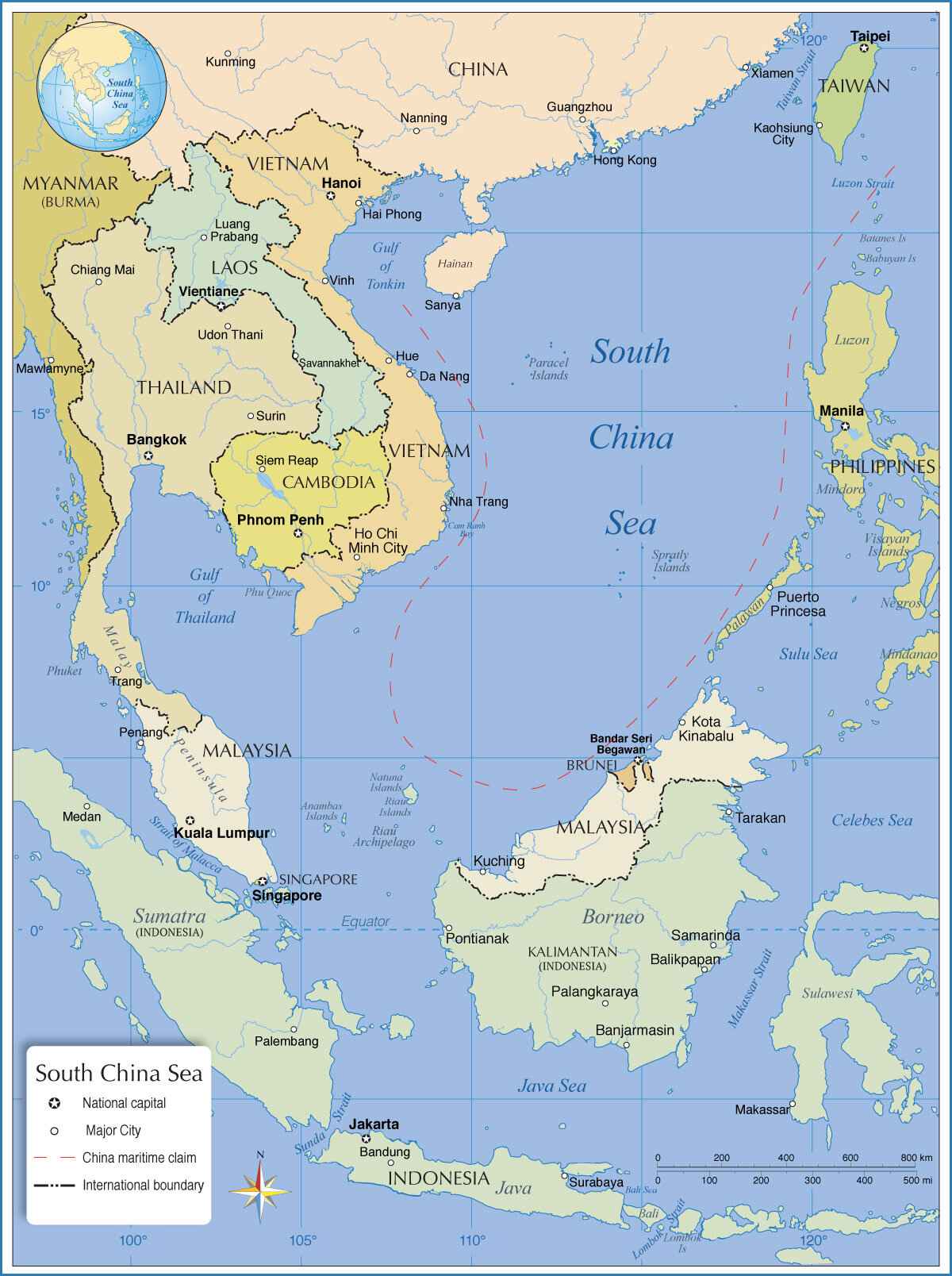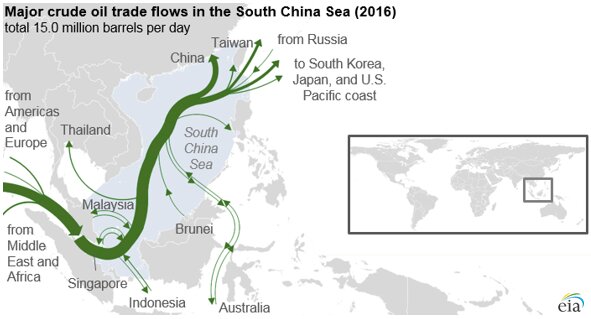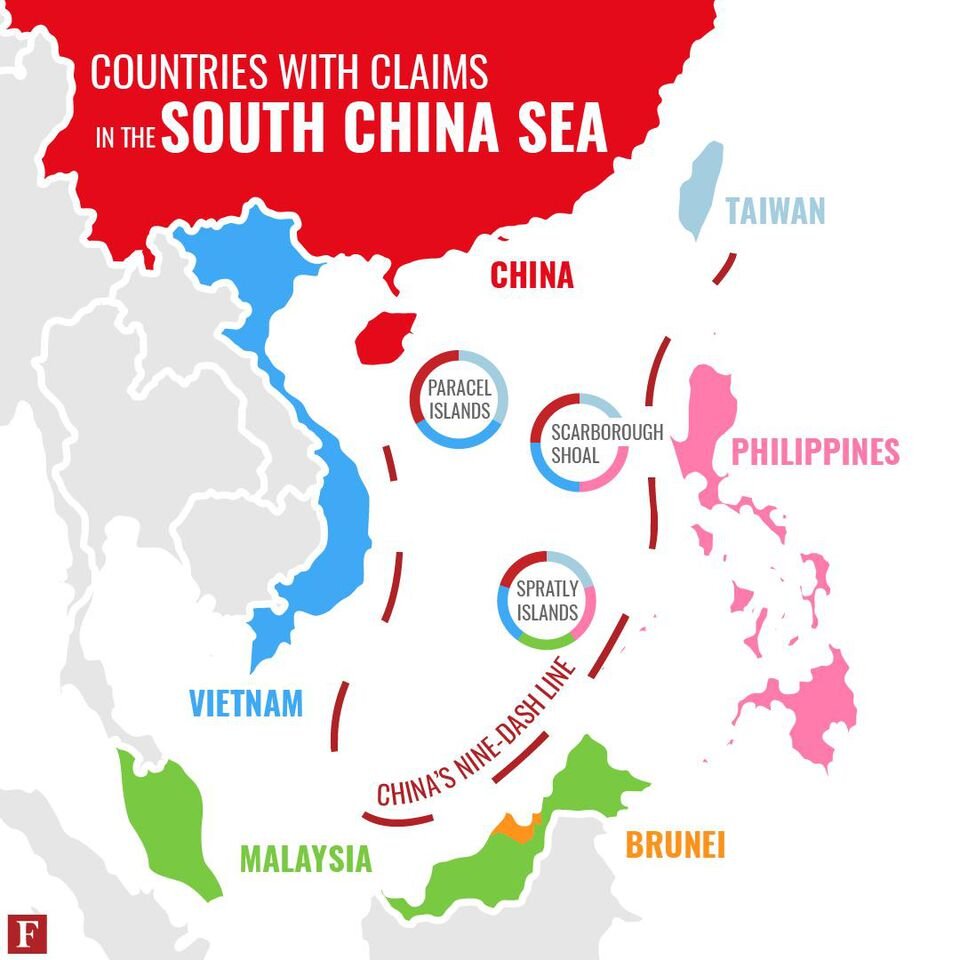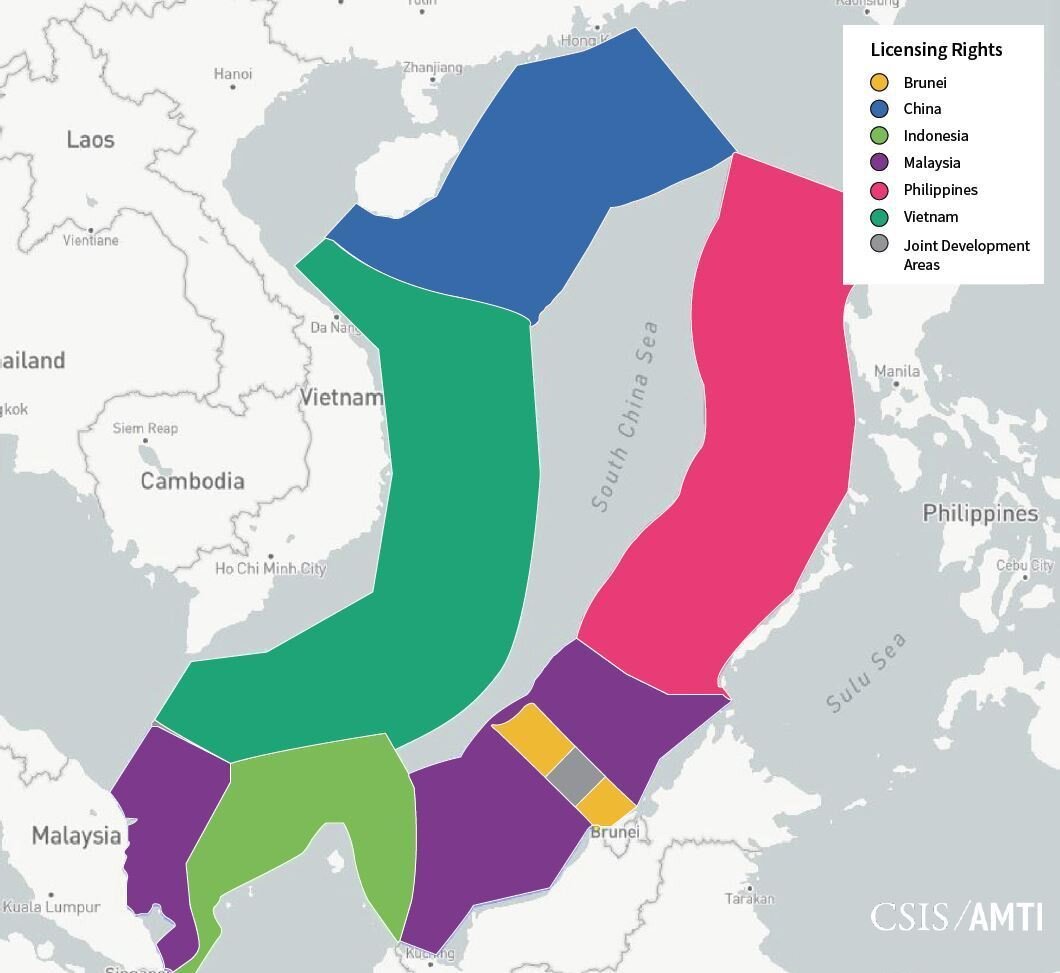South China Sea
Why in news?
- Recently, at the Indian Ocean Conference (IOC) in Maldives' Male, US Ambassador to South Korea attacked China for illegally building artificial islands and militarising them in the South China Sea to which China responded by saying that it has indisputable sovereignty over the Nansha Islands (Spratly Islands) and the adjacent waters of the sea.
- Addionationally, China rejected a UN-backed international tribunal ruling and said that dispute of South China Sea is not up for negotiation to the visiting Philippine President.
Indian Ocean Conference- IOC 2019
- Organised by India Foundation in association with Government of Maldives and S. Rajaratnam School of International Studies, Singapore in Male, Maldives.
- It was the 4th edition of IOC with the theme of "Securing the Indian Ocean Region: Traditional and Non-Traditional Challenges".
- Main topics of discussion were- Marine Ecology, Terrorism and Navigational Security.
International Tribunal for the Law of the Sea (ITLOS)
- Came into existence following the entry into force of the United Nations Convention on the Law of the Sea (UNCLOS), on 16 November 1994.
- UNCLOS, also known as Law of the Sea Convention or the Law of the Sea Treaty is the international agreement that resulted out of the third United Nations Conference on the Law of the Sea.
- It defines the rights and responsibilities of nations with respect to their use of the world's oceans, establishing guidelines for businesses, the environment, and the management of marine natural resources.
- Headquartered at Hamburg, Germany.
- Currently 168 members.
- An independent judicial body that maintains close links with the UN and both have entered various agreements concerning cooperation and relationship.
South China Sea
- South China Sea is an arm of western Pacific Ocean in Southeast Asia.
- It is south of China, east & south of Vietnam, west of the Philippines and north of the island of Borneo.
- Bordering states & territories (clockwise from north): the People’s Republic of China, the Republic of China (Taiwan), the Philippines, Malaysia, Brunei, Indonesia, Singapore and Vietnam.
- It is connected by Taiwan Strait with the East China Sea and by Luzon Strait with the Philippine Sea.
- It contains numerous shoals, reefs, atolls and islands. The Paracel Islands, the Spratly Islands and the Scarborough Shoal are the most important.
What makes it so important?
- This sea holds tremendous strategic importance for its location as it is the connecting link between the Indian Ocean and the Pacific Ocean. (Strait of Malacca)
- According to the United Nations Conference on Trade And Development (UNCTAD) one-third of the global shipping passes through it, carrying trillions of trade which makes it a significant geopolitical water body.
- According to the Department of Environment and Natural Resources, Philippines, this sea has one-third of the entire world’s marine biodiversity and contains lucrative fisheries providing food security to the Southeast Asian nations.
- South China Sea is believed to have huge oil and gas reserves beneath its seabed.
United Nations Conference on Trade And Development (UNCTAD)
- Permanent intergovernmental body established by the United Nations General Assembly in 1964.
- Headquartered in Geneva, Switzerland.
- Part of the UN Secretariat and the United Nations Development Group.
- Main UN body dealing with trade, investment and development issues.
Timeline
- 1994 – The Convention on the Law of the Sea went into effect. The United States called this treaty the “Law of the Sea Convention.”
- 1997 – Beijing shared the first rendering of its “Nine-dash Line” extending roughly 1,118 miles from Hainan Island to waters off equatorial Borneo under China’s historical claim of having it in the past.
- 2002 – ASEAN and China signed the Declaration on the Conduct of Parties in the South China Sea.
- 2009 – China issued two diplomatic notes that appear to claim a majority of the South China Sea.
- 2013 – The Philippines challenged China’s claims of historic rights and other actions in an arbitration case under the Law of the Sea Convention.
- 2016 – The Arbitration Tribunal ruled in favor of the Philippines and rejected China’s maritime claims that go beyond the entitlements set out in the Convention.
Nine Dash Line
- Stretches hundreds of kilometers south and east of China’s southerly Hainan Island, covering the strategic Paracel and Spratly island chains.
- China claims it by citing 2,000 years of history when the two island chains were regarded as its integral parts.
Issues Involved
- China claims most of the contested sea, reaching almost to the philippines shores and has built artificial islands with heavy military developments on them which worries the neighbouring nations and it rejects the UN backed international tribunal ruling as well.
- The nine dash line asserted by China violates the principle of Exclusive Economic Zones (EEZ).
- The stalled negotiations between China and ASEAN made headway on Code of Conduct as four of the ASEAN nations also made territorial claims on the disputed waters which adds to the problem with already non-negotiable behaviour of China.
Exclusive Economic Zones (EEZ)
- It is a formula based on compromise and was recognized by the UN Conference on the Law of the Sea in 1976.
- It covers an area beyond and adjacent to the territorial sea: it can extend to a maximum of 200 nautical miles from the baselines.
- Activities allowed in EEZ are -
- creation and use of artificial islands, installations and structures.
- marine scientific research.
- the protection and preservation of the marine environment.
Challenges
- China’s behavior of negligence, denial and the sense of superiority while overlooking international laws and regulations like the UN Convention on the Law of the Sea.
- Along with China’s bullying tactics, North Korea’s provocative behaviour has attracted US aircrafts in the already troubled waters. The growth of military vessels and planes in the area makes it more challenging to handle.
- Undefined geographic scope of the South China Sea; disagreement over dispute settlement mechanisms; different approaches to conflict management (self-restraint, mutual trust, and confidence building); and the undefined legal status of the Code of Conduct (COC) add to it.
- The different histories of distant, largely uninhabited archipelagos of the sea make the matter more complicated and multifaceted.
Achievements
- The members of the Association of Southeast Asian Nations (ASEAN) and China engaged in discussions on a potential COC to manage the South China Sea maritime and territorial disputes for a very long time and finally settled for a non-binding Declaration on the Conduct of Parties in the South China Sea (DOC) in 2002. In 2005, the first draft of guidelines to implement the DOC was drawn up, but not adopted until 2011. However, problems still linger so a plan for more robust policies is needed.
- After the consultations of 2016, in 2017 ASEAN and China adopted a bare-bone framework for the COC.
Declaration on the Conduct of Parties in the South China Sea (DOC), 2002
- ASEAN and China agreed to promote a peaceful, friendly and harmonious environment in the South China Sea for the enhancement of peace, stability, economic growth and prosperity in the region.
- It reaffirms respect for and commitment to the freedom of navigation and overflight above the South China Sea as provided for by the universally recognized principles of international law, including the UN Convention on the Law of the Sea.
Suggestions
- New arbitration processes to bring necessary mediation, facilitation and binding resolution mechanism which can move the military dispute to border management and to joint development finally.
- Adopting the concept of joint development zones, which resolves the territorial disputes and allows to pursuit of joint commercial activities, environmental protection, disaster relief and humanitarian perspective and counter-piracy control.
- International disputes should be settled by peaceful means in line with international laws on the principle of safeguarding maritime security, navigation and overflight rights and freedoms.
India’s Stand on South China Sea Issue
- In a Joint Strategic Vision for the Asia-Pacific and the Indian Ocean Region, India and the USA talked about ensuring freedom of navigation and resolving disputes according to UNCLOS referring to the South China Sea but after Philippines won the arbitration award in its favour in 2016, India has clearly separated itself from the dispute.
- New Delhi has not conducted any defence cooperation, navigational patrols and naval exercises with the claimant states in the South China Sea (only recently it conducted a naval exercise with Vietnam).
- After the recent development of affairs with Japan and Russia, it might appear that India wants to raise its strategic presence in the South China Sea but it is not so. Firstly, because India is not a party to the maritime territorial disputes in the region and does not want to interfere. Secondly, India wants to preserve its “Wuhan Consensus” with China, in which both nations respect each others’ spheres of influence in their adjacent water bodies.
Way Forward
- Forming an overarching authority like NATO or European Union (EU) with China as a member, in Asia to settle grievances and specifically find solutions to Asian problems, might help resolve disputes like this.
- The sense of power of China needs to be checked so that it abides by the intergovernmental and international agreements and conventions.
- Peaceful bilateral or multilateral talks and negotiations can be used because aggression or war is not a solution to this or any problem at all.


